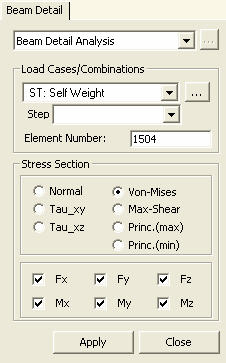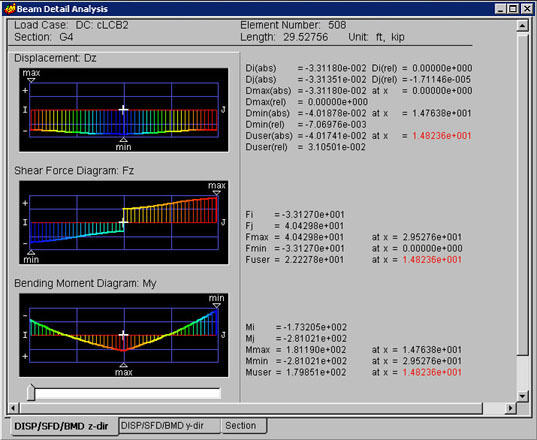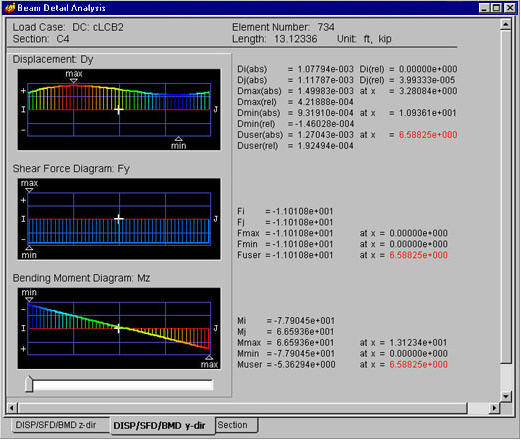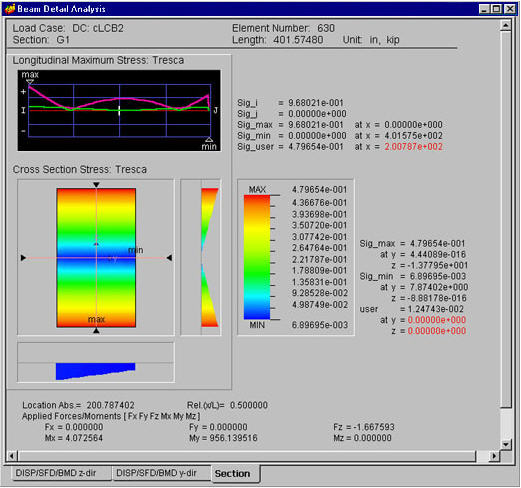Beam Detail Analysis
|
|
|
|
|
|
Produce a detail deformed shape, SFD/BMD, maximum stress distribution and sectional stress distribution diagrams for a particular section. |
|
|
|
|
|
|
|
From the Main Menu select Results > Beam Detail Analysis.
Select Results > Beam Detail Analysis in the Menu tab of the Tree Menu. |
|
|
|
|
|
Load Cases/Combinations
Select a desired load case or load combination.
Click to the right to enter new or modify existing load combinations. (Refer to "Load Cases / Combinations")
Element Number
Note
When the element is assigned, the following results window is displayed.
Deformed shape in the element's local z-direction and SFD/BMD
DISP/SFD/BMD z-dir. Results Window
Produce deformed shape, SFD and BMD for the beam element's strong axis
Displacement:
Dz
Di (abs) : Absolute displacement at node i (N1)
Dj (abs) : Absolute displacement at node j (N2)
Di (rel) : Relative displacement at node i (N1)
Dj (rel) : Relative displacement at node j (N2)
Note
Dmax (abs) : Maximum absolute displacement and the position
Dmax (rel) : Maximum relative displacement
Dmin (abs) : Minimum absolute displacement and the position
Dmin (rel) : Minimum relative displacement
Duser (abs) : Absolute displacement and the position at the location assigned by the user
Duser (rel) : Relative displacement and the position at the location assigned by the user
Note
Shear Force
Diagram: Fz
Fi: Shear force at node i
Fj: Shear force at node j
Fmax: Maximum shear force and the position
Fmin: Minimum shear force and the position
Fuser: Shear force and the position at the location assigned by the user
Bending
Moment Diagram: My
Mi: Bending moment at node i
Mj: Bending moment at node j
Mmax: Maximum bending moment and the position
Mmin: Minimum bending moment and the position
Muser: Bending moment and the position at the location assigned by the user
Deformed shape in the element's local y-direction and SFD/BMD
DISP/SFD/BMD y-dir. Results Window (Refer to DISP/SFD/BMD z-dir. Results Window)
Produce the deformed shape, SFD and BMD for the beam element's weak axis
Displacement:
Dy
Shear Force
Diagram: Fy
Bending
Moment Diagram: Mz
Detail section stress
Section Results Window
Entry
Section
Stress
Stress components
Normal
Tau-xy: Shear stress in the element's local y-direction ( )
Tau-xz: Shear stress in the element's local z-direction ( )
von-Mises von-Mises Stress =
where,
: Maximum principal stress
: Minimum principal stress
Tresca Tresca Stress =
Member Force Components
Fx: Axial force in the element's x-direction
Fy: Shear force in the element's y-direction
Fz: Shear force in the element's z-direction
Mx: Torsional moment about the element's x-axis
My: Bending moment about the element's y-axis
Mz: Bending moment about the element's z-axis
Output
Longitudinal
Maximum Stress component along the length of a beam.
Sig-i: Maximum section stress at node i (N1) ( )
Sig-j: Maximum section stress at node j (N2) ()
Sig-max: Maximum stress and the position ()
Sig-min: Minimum stress and the position ()
Sig-user: Maximum stress at the location assigned by the user ()
Note
Cross Section
Stress
Sig-max: Maximum stress and the position in the section ()
Sig-min: Minimum stress and the position in the section ()
Sig-user: Stress at the position assigned by the user ()
Assign the desired position (on the element's local y-z plane) in the section stress distribution diagram by moving the mouse cursor to the left or right and up or down. In addition, assign the desired position along the length (in the element's local x-axis) by moving the mouse cursor to the left or right in the maximum stress graph.
Location
abs: Distance from the i node to the position assigned by the user
rel (X/L): Distance ratio relative to the total length for the position assigned by the user
Applied Forces/Moments [Fx, Fy, Fz, Mx, My, Mz]: Member forces at the position along the length assigned by the user
Note When stress checks are required for a tapered section, its section information such as DB/User and PSC(DB) types is required to produce stresses at the positions (1/4, 1/2 & 3/4). In contours, diagrams and tables, section properties at the positions (1/4, 1/2 & 3/4) are obtained by interpolation between i-end and j-end. Whereas in Beam Detail Analysis, the section properties at the positions (1/4, 1/2 & 3/4) are re-calculated using the section shape information at the corresponding positions. If section properties are not defined in a section, stress results will not be generated.
|
|
|




 .
.